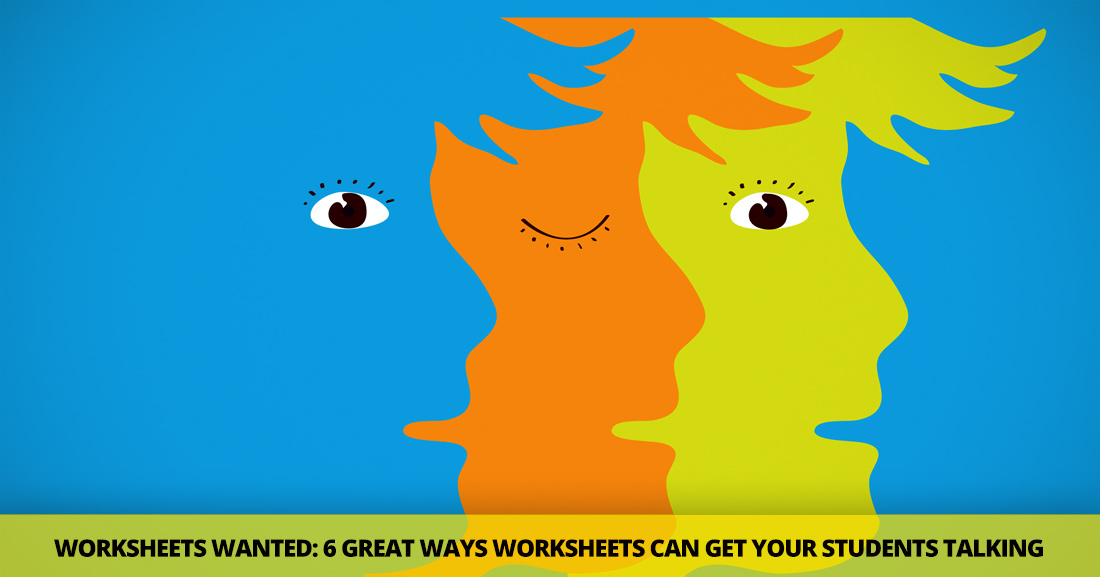Donít Ditch Dictation: 4 Fabulous Ways You Can Use Dictation to Help ESL Students


They have a reputation for being busy work, pointless activities to keep students hands moving even if their brains are a million miles away. But worksheets don’t have to be mindless. In fact, you can do lots of activities with them that get students talking and using English in useful ways. If you want to give it a try, here are some ways you can use worksheets to get your ESL students talking.
Your students can learn grammar while they talk with a partner when you use the discovery grammar method with just about any grammar worksheet. To do this, put students in groups of two or three. Choose a grammar worksheet that covers a topic your students have not yet learned. Give each person a worksheet with the answers handwritten in. Then ask students to figure out the rule for the answers. Since they already have the right answers in front of them, they should be able to determine how those answers are formed. Then have students come up with a possible rule for the grammar construction. Follow that discussion by teaching your students how to correctly use the grammar construction. Odds are they will have figured it out on their own already which will cement it in their minds and appeal to your mathematical/logical learners as well. They will have learned the concept on their own and your instruction will just reinforce what they have already figured out.
Writing prompts are prevalent in the world of worksheets. You can even print a different writing prompt for every day of the year at this website. But instead of giving the prompts to your students and asking them to write, have them talk about the prompt instead. For example, if you give your students a writing worksheet that asks what is your favorite day of the year? Have them talk about it instead of writing out their answer, working with a partner to talk about the day and what makes it special. This starting place can and will lead to a great conversation with a classmate, and if you want to have them follow up the discussion by writing out their answer, you’ll get twice the great output from one simple worksheet.
You can still use worksheets to practice grammar and get conversation in at the same time. Partner up your students, and then give each pair only one worksheet. One person has possession of the worksheet for the entire activity, and the other person is not allowed to look at it at all. The students work together, the first person asking his partner the questions on the worksheet and the second person giving the answers. The person with the paper is not allowed to give the answers himself. If you want to give your students equal time answering questions, divide your worksheet in half. Once the first half is completed this way, give the other half to the second student and have her ask her partner for the answers this time.
Not every worksheet you use in an ESL class has to be an English worksheet. Try giving your students a science worksheet such as this one on what plants need to grow. Review the worksheet with your class and make sure they understand the information presented on it. Then have them work with a partner or two other students to design an original experiment based on the information in the worksheet. So for this worksheet, students might try growing plants without each of the elements listed by not watering one, putting one in a dark closet to grow, etc.
You can use a reading worksheet to get your students moving around class and talking to each other. Choose a short reading comprehension worksheet such as this one on the Australian Dingo or any other worksheet that has a short reading passage along with some questions. Separate the reading paragraph from the questions and give each pair of students only the question portion of the worksheet. Post the paragraph on your front board. Each student will work with a partner. One person is the reader. The other person is the answerer. The answerer starts by asking his partner one of the questions on the sheet. The reader must then go to the reading passage and find that information in the paragraph. He returns to his partner and tells her what he read in the paragraph. The two decide on the answer together and the answerer writes it on his paper. The activity continues this way – the answerer only allowed to look at the questions and the reader only allowed to look at the paragraph. Once students have completed the questions, have them check their answers with you before giving them another set of questions and posting a new paragraph. This time students switch roles for the activity.
There is no need to reinvent the wheel when it comes to getting students talking. A simple conversation worksheet can be all you need to get students chattering away. Worksheets like this one which give several conversation questions can be used just the way they are. But you can also take these worksheets to the next level. Try giving three or four students a worksheet such as this one. Then challenge them to come up with their own game using the questions on the sheet. They might design a board game or a card game or something else entirely. After each group comes up with how to play its game, have each group present their game to the class. After all the presentation, have the class vote on which game they would most like to try and then give that one a go.
With these activities that take worksheets and make them into discussion starters, you can feel good about passing out those papers in class.